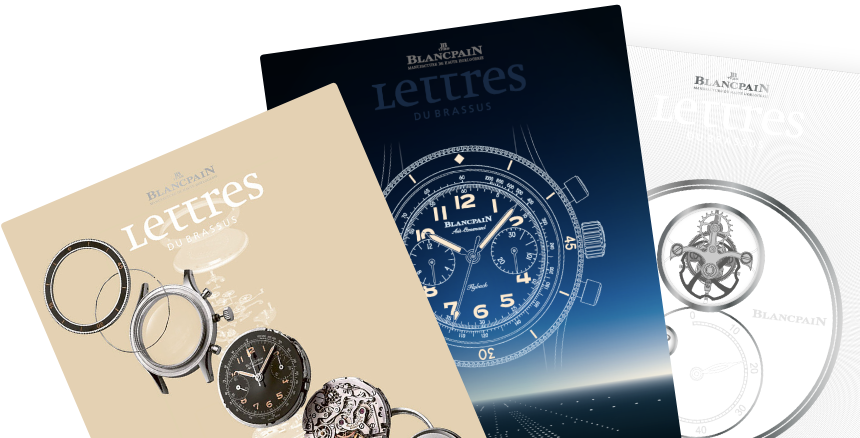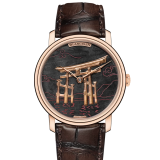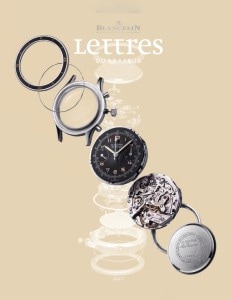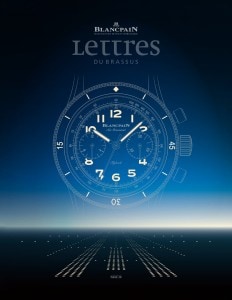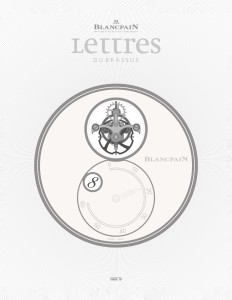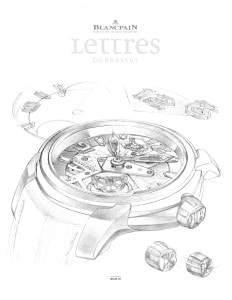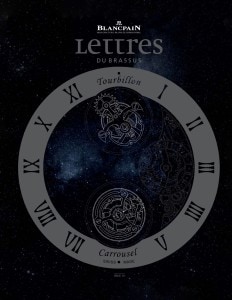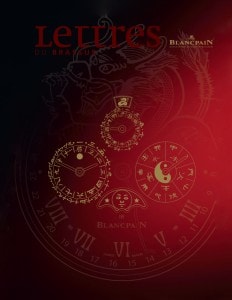
Search in Issues
Chapters
Chapter 2
BINCHOTAN
The deep black hues and subtle wood graining of Japanese Binchotan charcoal become the canvas for special Blancpain dials.
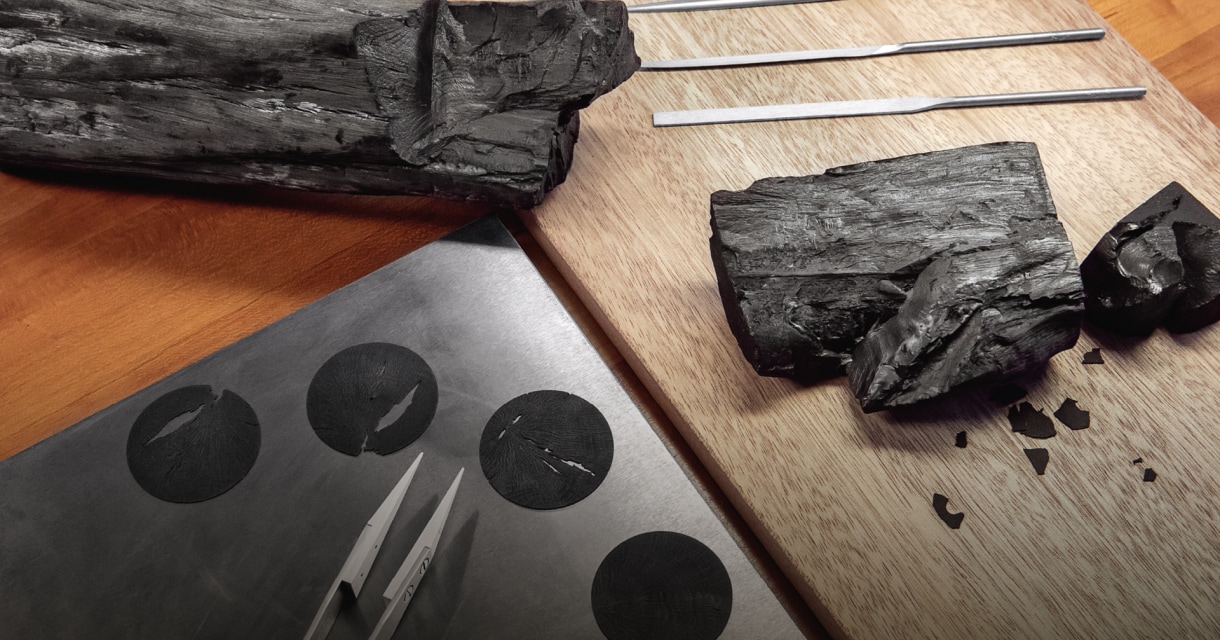
If you are a knowledgeable foodie, the title “Binchōtan” is likely to prove disorienting. Binchōtan is known as the world’s finest charcoal for grilling. It is essentially pure carbon, with all impurities burned off during its production. Thus, it is odorless and is prized, particularly in Japan, for yakatori and grilling of fresh water fish whose delicate flavors are preserved and left unaltered by competing tastes as usually occurs with other grilling charcoals. Certainly, with its virtues so well known and revered in the food world and, taking note of our devotion to restaurant and wine articles as highlights in every issue, there can be no doubt as to binchōtan meriting attention as a subject for our art de vivre sections. Trouble is, this story focused on binchōtan is not about fine cuisine; it is about art.
Historically métiers d’art and horology have been so closely bound together for centuries that their traditions have grown to be intertwined. In Blancpain’s estimation, although the tradition of bringing art to the watch is an honored and revered one, indeed to such an extent that Blancpain is proud to be the home in its Le Brassus workshop of one of the largest groupings of artists in the watch world, this does not mean that the particular art forms practiced should be frozen in time. Blancpain’s artisans are given free rein to discover new materials, crafts, and motifs which have not graced timepieces before. Over the past few years the arc of their creativity has claimed watchmaking world firsts with dials featuring ancient damascene and shakudō designs. Their discovery of binchōtan represents a continuation, a third world-first achievement.
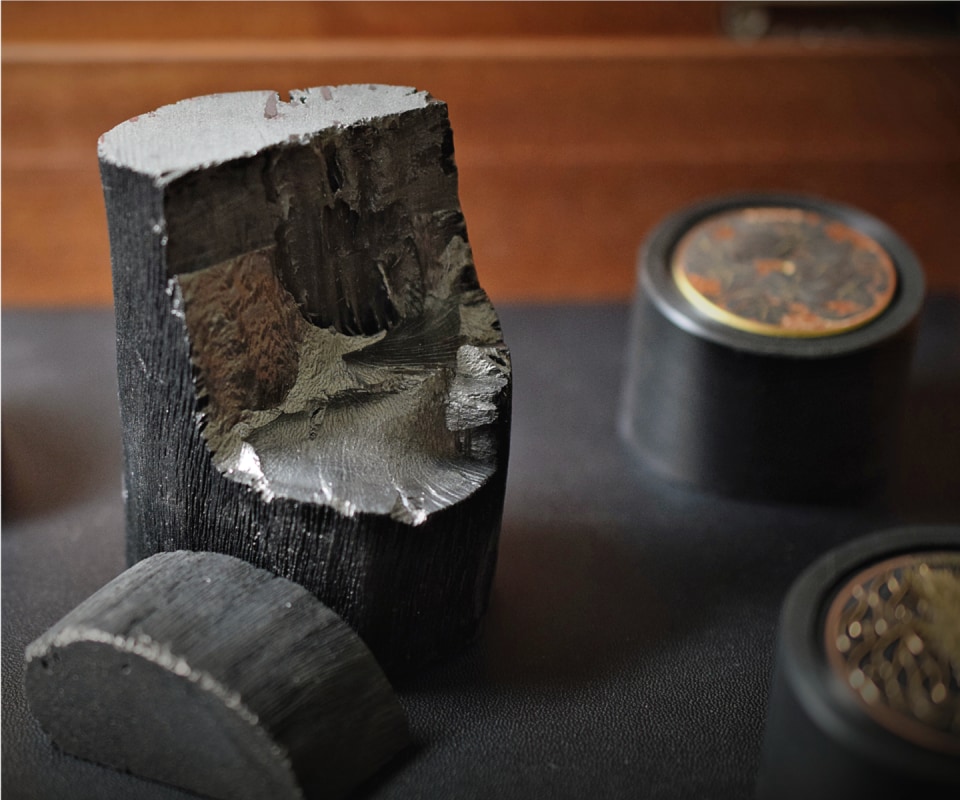
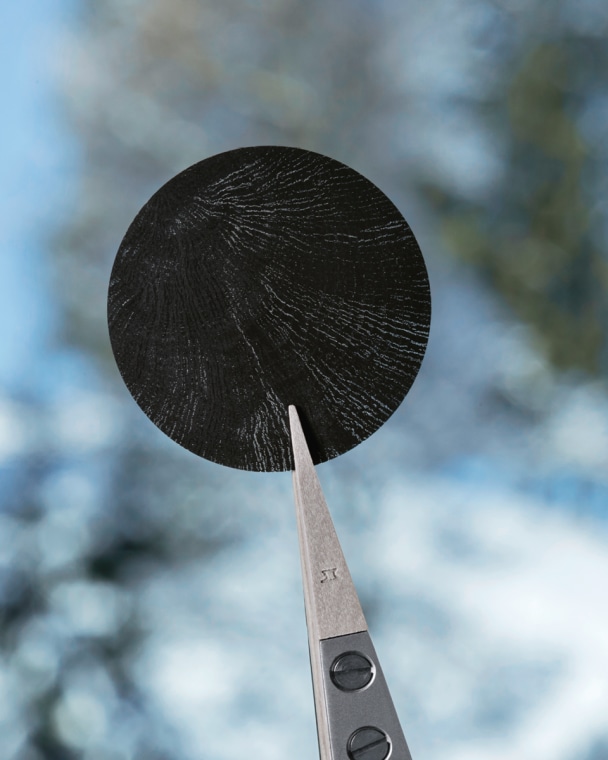
CREATIVITY is perceiving something familiar in an UTTERLY NEW FASHION.
The artists in Blancpain’s Métiers d’Art studio in Le Brassus have imagined binchōtan in an entirely novel way. Creativity is perceiving something familiar in an utterly new fashion and that’s what happened when binchōtan came to their attention. What attracted them to binchōtan was the color black enriched with wood grain. Encountering a few simple binchōtan pieces of jewelry, all unembellished, solid black in color without further decoration, set Blancpain on the quest to determine if this unique Japanese charcoal with its deep black color and natural grain could be adapted for use as a watch dial.
Whereas the vast majority of others have, of course, considered it only as a cooking fuel, a very few as a material for purification of air and liquids, and far fewer still as a material for some simple decorative objects such as pendants, Blancpain’s artists saw its subtly textured black surface as an intriguing canvas that could be embellished for a watch dial.
No doubt that our readers are familiar with more pedestrian forms of cooking charcoal… soft, fragile, and, most worrying of all, prone to disintegration into dust. Not only do these attributes commend little for horological applications, they all seem to be enemies of fine watchmaking, particularly the dust. Because it is produced in an entirely different way, binchōtan has none of these properties. It was developed three centuries ago in Japan’s Kishu province. The process to produce it is unusually elaborate. It begins with harvesting branches of Ubame, a species of particularly hard oak that grows in the Kishu hills. Even centuries ago, the harvesters were sensitive to the issue of sustainability, as the trees themselves were not
Binchōtan’s EXTRAORDINARY HARDNESS approaches that of STAINLESS STEEL.
felled, nor were branches removed from the live trees. Instead, then as now, the raw material consists uniquely of fallen branches which are gathered and then stacked and burned slowly at reduced temperatures within kilns built into the hillsides. This initial slow controlled burn lasts several weeks. Managing the amount of oxygen is key to this prolonged step. Thereafter, the temperature is allowed to rise to more than 1000°C. The smoke is carefully monitored until it is of a pure white color which signals that all impurities have been burned off. The result is charcoal of near 100% pure carbon. When it is removed from the kiln, there is one last step for the binchōtan destined for cooking. The wood is smothered in soil mixed with white ash to extinguish the fire. This imbues the carbon with a subtle gray exterior, leading some to refer to the cooking version as “white charcoal”. This process, developed by Binchoya Chozaemon, whose name it now bears, was for many years a closely guarded secret. Although there are now kilns elsewhere in Japan, the traditional artisanal methods of Kishu are esteemed to produce the finest and highest quality binchōtan.
The first thing the Le Brassus artists determined was that, unlike common forms of charcoal, binchōtan’s extraordinary hardness approaches that of stainless steel. This was a fortunate discovery as it allows binchōtan to be sliced, precisely cut, drilled and polished to form a surface suitable for the dial of a timepiece.
Since this was another first for watchmaking, they had no guidebook on how to proceed. The initial step was to obtain the highest quality binchōtan from Japan. The gray exterior coating, no obstacle for culinary uses, had to be removed to uncover the pure grained black. Fortunately, washing several times did the trick.
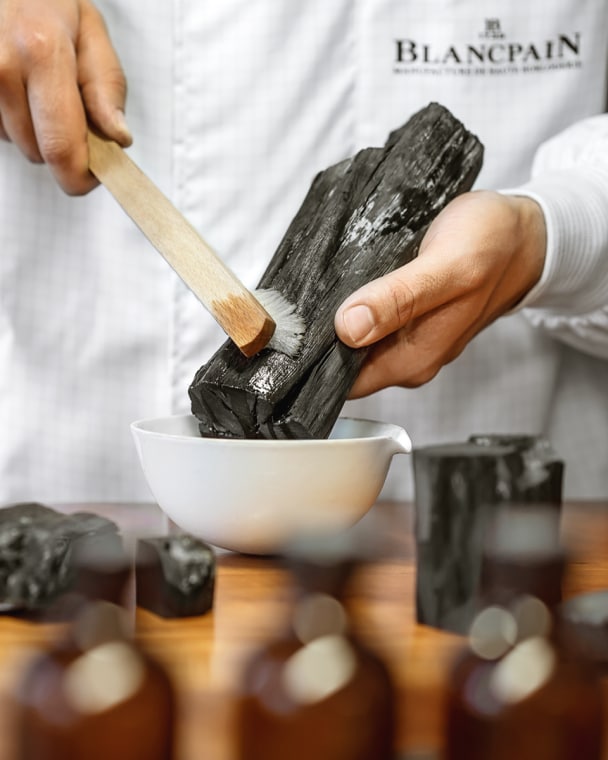
The first step in the process: washing off binchotan’s white coating.
The next step was the adaptation of slices for dial use. Because binchōtan is a natural material, the quality of the slices is highly variable and often unpredictable when viewing the charcoal branch from the outside. Owing to its oak origins, as the charcoal branch is cut, various holes, cracks, or, in some cases, unattractive knots, hidden from the outside, are revealed.
Multiple slices are the order of the day to be able to select disks with an attractive grain pattern. Following the selection of preferred slices, cutting to size and drilling are accomplished. Once all of these steps were mastered, Blancpain’s artists had their black grained dial canvas ready to be embellished with additional decoration.
Each Blancpain métiers d’art creation is a pièce unique, a limited edition of one. Binchōtan is faithful to this credo. The first four binchōtan dials showcase the range of binchōtan’s use and the additional artistic crafts that can be employed to embellish and accompany this unique black canvas.
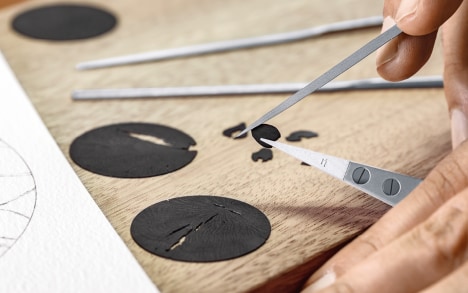
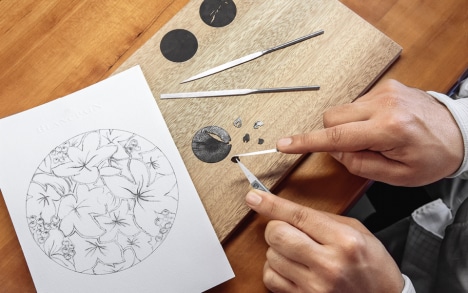
Blancpain follows ANCIENT JAPANESE tree sap LACQUERING METHODS.
The first to debut was a piece entitled “Shinto Gate”. For the Shinto dial, the entire background of the dial is realized in binchōtan. Lacquer is used to prepare
the binchōtan surface for the additional artworks.
Although Japan is renowned for its mastery of lacquer crafts, its origins are in China where the techniques were first discovered to create lacquer from tree sap. The Chinese initially employed it for opulent precious objects, some entirely crafted in lacquer, and for entombing nobility, selecting it for its stability over time. In Japan, where lacquer has flourished as an art form, as in China, similar methods are used for formulation using the sap of selected trees.
Blancpain adheres to these ancient tree sap lacquer traditions. Before the tree sap lacquer is painted upon the binchōtan surface, it is passed through an extremely fine cloth to ensure its purity. Thereafter, several clear coats are carefully brushed upon the top surface of the binchōtan, each one requiring two days to cure. Not only does this lacquer coating process give a subtle sheen to the top surface, highlighting the natural grain, but the preservative qualities, initially discovered by the Chinese, confer an added bonus.
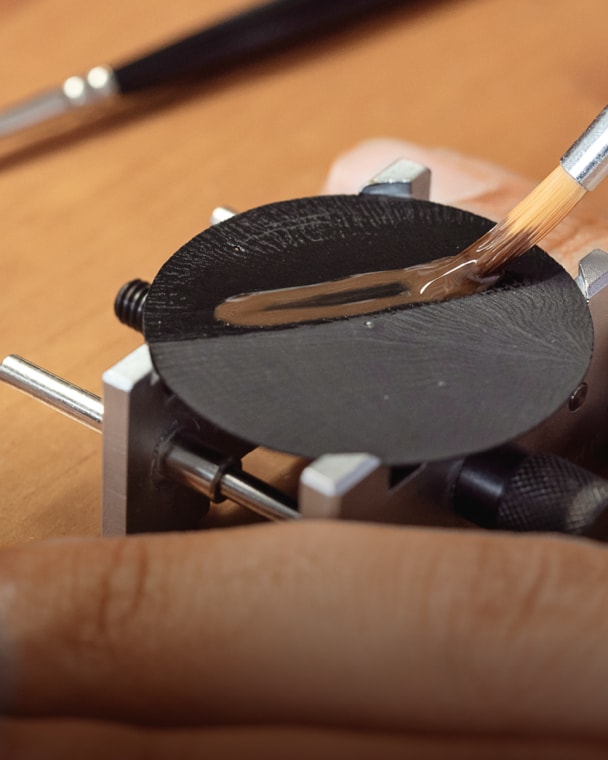
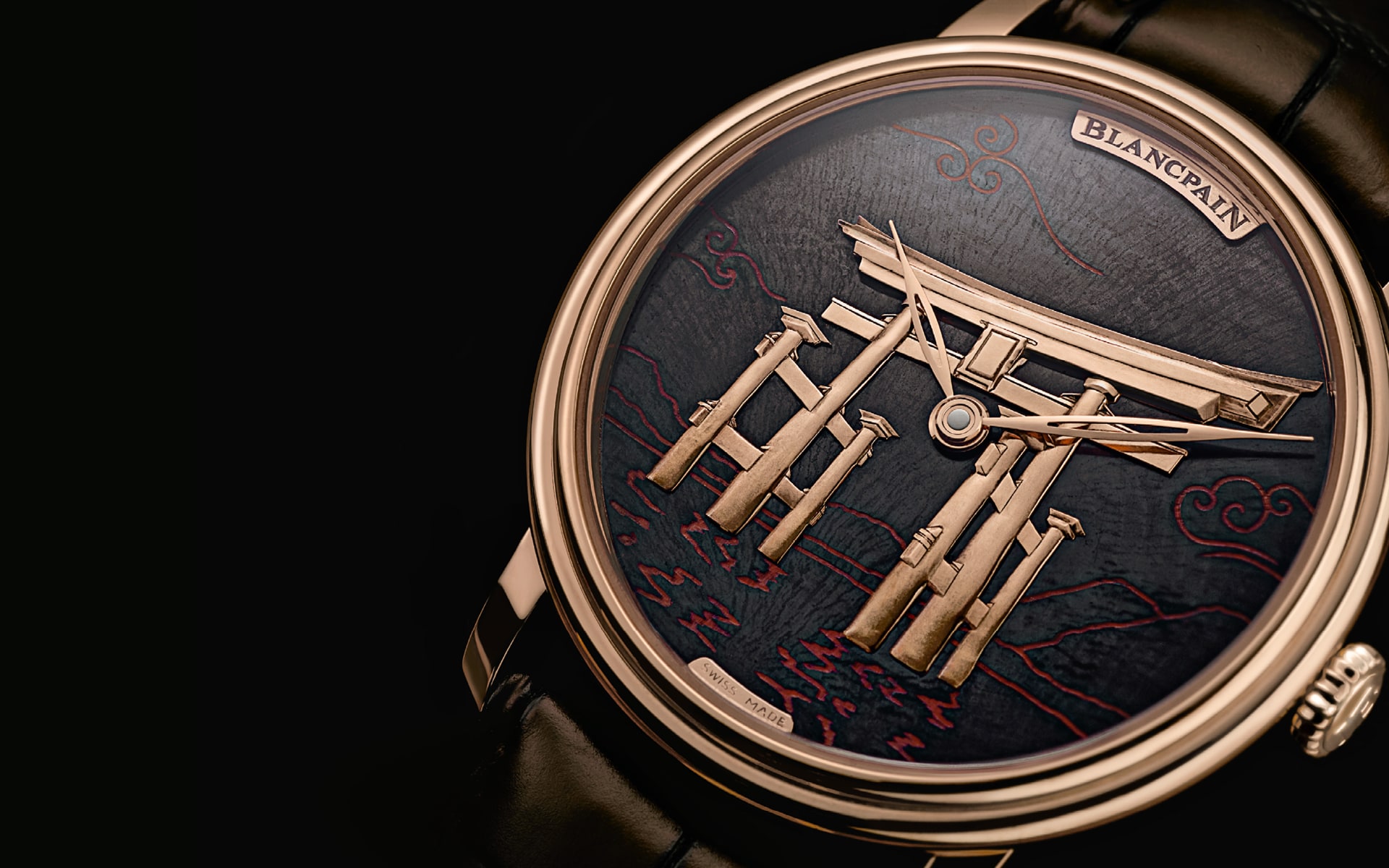
Following the completion of the clear lacquer coating, a finely carved, three-dimensional red gold applique in the form of a gate, supported by three columns on each side, is poised upon the surface in the center of the dial. Surrounding the gate is an understated line drawing of shimmering water, background hills, and clouds. The medium for the fine drawing re-enforces the Japanese theme as it is painted with traditional red Urushi lacquer which is imported from Japan. Extremely fine brushes are required for the delicate red lines.
Entirely different techniques were employed to create the “Fleur de Lys” dial. Instead of a binchōtan base, the Lys dial begins with a red gold base. The gold is finely carved to create recesses for the two designs which are featured: lilies and small red fruits. When the carving step is completed, thin gold threads remain, outlining the shapes of the lilies and fruits. The recesses for the fruits are filled with red enamel and fired at 800°C. The lilies draw upon even finer artistic skill as each one must be carved into the precise shapes of the fine gold threads outlining the recesses. In some ways the design can be thought of as a blend of the ideas behind two revered traditional artistic crafts: marquetry, the fitting together of delicately carved elements to create a design, and champlevé, the carving of a gold surface to create recesses into which enamel is applied with a small brush. Many slices of binchōtan are used as the artist not only has to select flawless areas from which to cut the outline of the flower, but a studied eye is required to orient the shape so that the grain harmonizes with the outline. Each one of the cut flower pieces is then given the same clear lacquer treatment as was used for the “Shinto Gate” dial. Following that they are fitted into the cut recesses so that each is surrounded by the fine gold threads. Once all the flower pieces are inlaid upon the dial, they are further decorated with fine gold lacquer paint. The gold lacquer is prepared by Blancpain, starting with a traditional tree sap lacquer that has been purified by passing through a fine cloth. Thereafter, the artists mix actual gold powder into the pure lacquer base. Extremely fine brushes are used to paint the lines upon the binchōtan flower inlays.
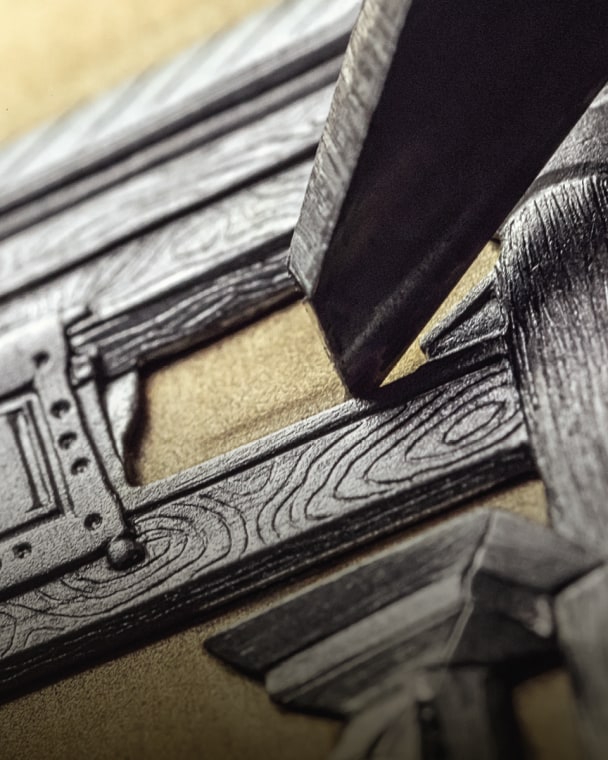
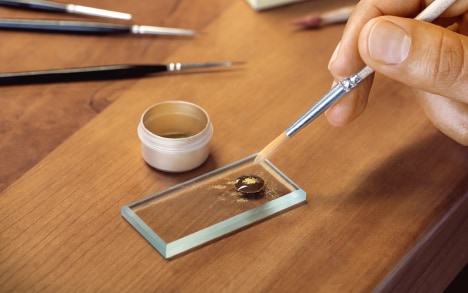
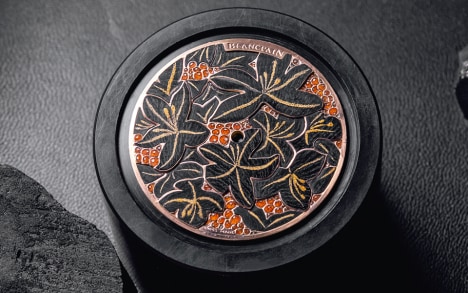
Yet another artistic method was used for the “Kurikara Fudo” dial. For this dial, a black binchōtan disk was laid upon a red gold base. Blancpain’s engravers carved a breathtakingly detailed image of a dragon in the form of the Buddhist deity “Acala”. To bestow a special patina on the elaborate carving, Blancpain called upon a technique which it pioneered in the world of horology, shakudō. The carving is dipped into a special chemical bath developed in Japan which brings subtle shadowy hues to the gold. After the patina has been achieved, a mother-of-pearl ball is set upon one of the arms of the dragon, secured by fine gold fingers. Not only is the dragon image finely carved, but surrounding its body are fine filigrees of gold which demand a deft touch both in their creation as well as when fixing them, together with dragon, upon the surface of the dial.
The fourth binchōtan dial offers a re-interpretation of Hokusai’s Great Wave off Kanagawa. This iconic image, created in 1830, captures the ferocious power of the sea during a storm. Blancpain first brought the force and dynamism of the Wave to a watch dial in 2016 with a fine white gold carving, subtly shaded with shakudō, laid upon a disk of Mexican obsidian (see Lettres du Brassus Issue 17). A new mood was achieved by placing a similarly carved wave upon a binchōtan disk.
Bringing binchōtan for the first time to the world of watchmaking, represents more than a new material and technique at the disposal of the artists in Le Brassus.
It emphatically re-enforces Blancpain’s openness to the expansion of the boundaries of métiers d’art and the constant search in the Le Brassus studio for new inspirations. •
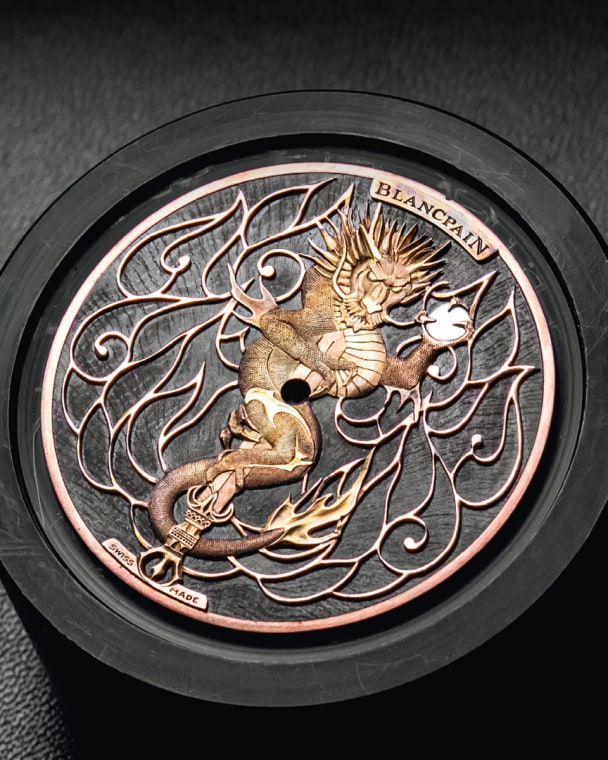
The “Kurikara Fudo” dial.
Other issues
Don't miss the latest issue
Sign Up for New Releases